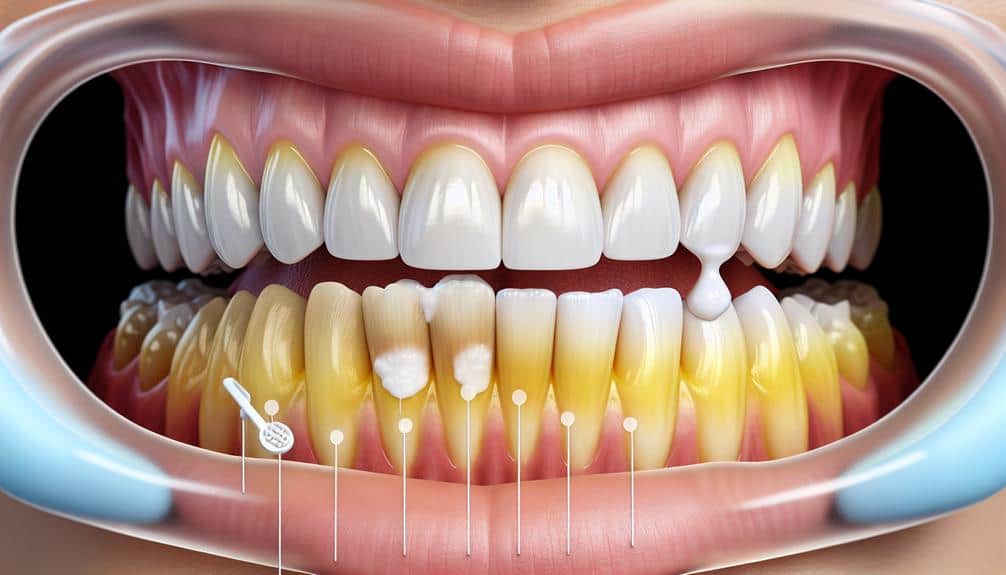To whiten genetically discolored teeth successfully, start by identifying the cause with a professional. Consider treatments like whitening, bonding, veneers, or crowns. Watch your diet, avoid acidic foods, and quit smoking to prevent further discoloration. Be patient as results may take time, but essential is key. Choose the right whitening option tailored to your needs, whether it's professional treatments or at-home solutions. Maintain your results by using a mouthguard, limiting staining substances, and following up with touch-up treatments. Proper oral hygiene is pivotal to preserving your brighter smile. Achieve effective results by understanding the causes and targeted treatments.
Key Points
- Seek professional consultation to determine the cause of discoloration accurately.
- Choose whitening treatments tailored to genetic factors affecting enamel and dentin.
- Follow whitening instructions diligently for optimal and lasting results.
- Maintain consistent whitening regimen for gradual improvement over time.
- Adopt oral hygiene practices and lifestyle changes to preserve whitening effects.
Understanding Genetic Tooth Discoloration
Genetic tooth discoloration is a condition that can be inherited and is characterized by changes in the color of the teeth due to genetic causes. This type of discoloration differs from extrinsic factors like staining from food or drinks. Understanding genetic tooth discoloration is vital in determining the appropriate treatment options.
Genetic causes play a significant role in the development of tooth discoloration. These causes can affect the thickness of the enamel, the structure of the dentin, or the overall mineralization of the teeth. When addressing genetic tooth discoloration, it's essential to take into account these underlying factors to determine the best course of action.
Treatment options for genetic tooth discoloration may vary depending on the severity of the condition. Common approaches include professional teeth whitening procedures, bonding, veneers, or crowns. In some cases, genetic tooth discoloration may require a combination of treatments to achieve the best results. Consulting with a dental professional is key to developing a personalized treatment plan tailored to your specific needs.
Factors Influencing Discoloration Severity
Understanding the various factors that influence the severity of tooth discoloration can aid in determining the most effective treatment approach for individuals with this condition.
Diet influences play a significant role in tooth discoloration severity. Consuming foods and drinks high in pigments like coffee, tea, red wine, and certain fruits can stain teeth over time, leading to more severe discoloration. Additionally, acidic foods and beverages can erode tooth enamel, making teeth more susceptible to discoloration.
Lifestyle habits also play an important role in the severity of tooth discoloration. Smoking and the use of tobacco products can cause yellowing and stubborn stains on teeth. Poor oral hygiene practices, such as infrequent brushing and flossing, can also contribute to the severity of discoloration. Neglecting regular dental check-ups and cleanings can allow stains to accumulate and worsen over time.
Choosing the Right Whitening Treatment
To achieve the best results when addressing tooth discoloration, it's important to select the most appropriate whitening treatment based on individual needs and the nature of the discoloration. For top-notch outcomes, consider seeking a professional consultation to determine the underlying cause of the discoloration and to receive personalized recommendations.
Professional consultations can help identify whether the discoloration is extrinsic, intrinsic, or a combination of both. Extrinsic stains are typically caused by external factors like food or beverages, while intrinsic discoloration originates from within the tooth. Depending on the type of discoloration present, different whitening treatments may be more effective.
When choosing a whitening treatment, you also have the option of at-home solutions. These can range from over-the-counter whitening strips and toothpaste to custom-fitted trays provided by your dentist. It's crucial to follow the instructions carefully and be consistent with the treatment to see noticeable results. By selecting the right whitening treatment with the guidance of a professional and considering at-home options, you can effectively address genetic tooth discoloration.
Consistency and Patience in Whitening Regimen
When starting on a whitening regimen, maintaining consistency and exercising patience are key factors in achieving desired results for addressing tooth discoloration. Importance in following a whitening routine is essential to allow the whitening agents to work effectively on your teeth.
Establish a consistent routine by adhering to the recommended usage frequency of the whitening product you have chosen. Remember, results may not be immediate, so patience is vital. Tooth discoloration typically improves gradually over time with consistent use of whitening treatments.
Maintenance Tips for Lasting Results
For maintaining lasting results in tooth discoloration treatment, incorporating proper oral hygiene practices alongside regular touch-ups can greatly prolong the effects of whitening treatments. Brushing your teeth at least twice a day with a whitening toothpaste can help prevent new stains from forming. Additionally, flossing daily can remove plaque and prevent discoloration between teeth. Regular dental check-ups and cleanings are essential for maintaining the results of whitening treatments and ensuring overall oral health.
- Preventive Care: Consider using a mouthguard if you tend to grind your teeth at night to prevent wear and tear that can lead to discoloration.
- Lifestyle Changes: Limit consumption of staining foods and beverages like coffee, tea, and red wine. Smoking can also cause tooth discoloration, so quitting can help maintain your bright smile.
- Regular Touch-Ups: Schedule touch-up whitening treatments as recommended by your dentist to combat any new discoloration and keep your smile looking its best.
Frequently Asked Questions
Can Genetic Tooth Discoloration Be Completely Reversed With Whitening Treatments?
You can improve but not completely reverse genetic tooth discoloration with whitening treatments. Success rates vary; professional treatments offer better long-term effectiveness. To maintain results, consider professional options, along with at-home care and regular maintenance tips.
Are There Any Specific Foods or Habits That Should Be Avoided to Prevent Further Discoloration?
To prevent stains and maintain tooth color, it's wise to avoid certain foods and habits. Coffee, tea, red wine, and smoking can lead to discoloration. Brushing after consuming stain-causing items can help prevent further discoloration.
How Long Should One Wait Before Seeing Results From a Whitening Treatment for Genetic Tooth Discoloration?
For genetic tooth discoloration, results from whitening treatments vary. Typically, noticeable changes may happen within a few weeks, but full effects might take a few months. Consistent follow-up care and maintenance tips are essential for lasting success.
Are There Any Alternative Treatments or Remedies for Genetic Tooth Discoloration Besides Whitening?
When dealing with genetic tooth discoloration, exploring natural remedies or professional solutions beyond whitening is essential. Consultation options can provide insight into home treatments or alternative procedures to address the issue effectively.
Can Genetic Tooth Discoloration Be Passed Down to Future Generations?
Can genetic tooth discoloration be passed down to future generations? Absolutely! Inherited traits play a significant role in dental issues. Family history and hereditary factors can influence the likelihood of passing on genetic tooth discoloration to your offspring.



